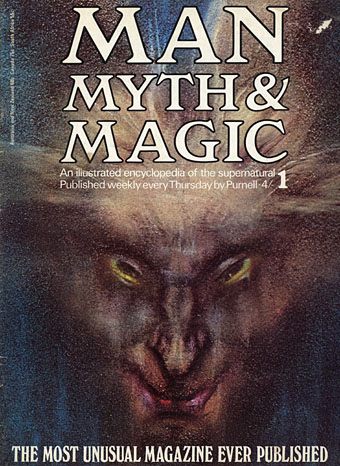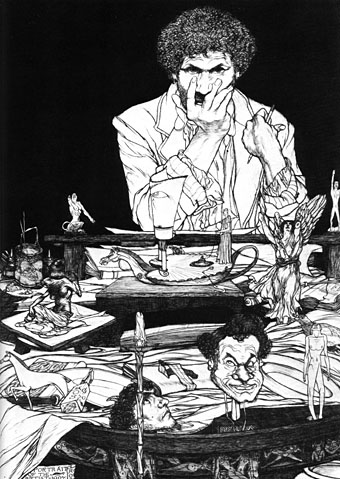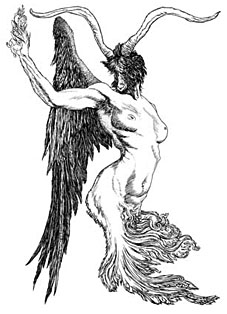
Today is the 50th anniversary of the death of one of my favourite artists, Austin Osman Spare.
Like many people in the 1970s, I was introduced to the work of Austin Spare by Man, Myth and Magic, a seven volume “illustrated encyclopedia of the supernatural” published weekly in 120 112 parts by Purnell. My mother was a Dennis Wheatley reader so we had a couple of occult paperbacks in the house, among them one of William Seabrook‘s accounts of voodoo in Haiti and a copy of Richard Cavendish’s wonderful magical primer, The Black Arts, (later retitled The Magical Arts). Cavendish had been chosen as editor of Man, Myth and Magic and included occultist and writer Kenneth Grant on his editorial staff, a decision that gave the book’s producers access to Grant’s collection of Spare pictures. In a rather bold move, they launched Man, Myth and Magic in 1970 with a detail of a Spare drawing on the cover, a work often referred to as The Elemental although the authoritative Spare collection, Zos Speaks has it titled as The Vampires are Coming. It’s a shame that AOS didn’t live for a few more years to see this; after labouring in poverty and obscurity for most of his life he would have found his work flooding Britain, with this first issue on sale all over the country and the cover picture being pasted on billboards and sold as posters. It’s possible there were even television adverts for the book (although I don’t recall any), since there usually were for expensive part works like this.

Spare was born in London in 1886 and like many other artists from the 19th and early 20th century had come back into favour thanks to the attentions of a new generation with an interest in mysticism and decadence. An Aubrey Beardsley renaissance that began in the mid-Sixties (Spare knew Beardsley’s sister, Mabel, and drew a portrait of her) pulled lesser-known artists into its orbit like Harry Clarke, (who Spare published in his magazine The Golden Hind) and Félicien Rops. Man, Myth and Magic was marketed as much at the hippie youth culture as at people with a vague occult interest like my mother; that first issue probably put Spare’s work before more people in a single day than had seen his work in his entire lifetime.
After the part-work Man, Myth and Magic had been running for a while, the first six issues were gathered together and sold as a bound book and it was one of these volumes that my mother bought. Eventually that book and all the other occult titles in the house ended up in my possession. The “elemental” picture wasn’t used on the book cover but was reproduced inside in black and white as illustration for an essay by Kenneth Grant on “Atavisms”. Grant very commendably had used his position as advisor on this high-profile publication to talk up Spare as much as possible, and devoted half the article to him. At the time I didn’t quite understand what exactly “resurgent atavisms” were supposed to be but the combination of those strange words and the three Spare pictures accompanying the article (plus others elsewhere in the book) made a profound impression. Unfortunately this was all I knew of the artist for some time until subsequent scouring of local libraries turned up more of his drawings in occult encyclopedias. Eventually I started to collect Grant’s own rather bewildering magical treatises, most of which involve some discussion of Spare’s techniques of sigil magic and include reproductions of paintings and drawings.
Looking back now it’s interesting to see how much my image of Spare as a person has altered over the course of thirty years. Grant’s discussion of magic in any context tends to play up the Lovecraftian dimension of the subject, presenting a world of serious, if not downright dangerous, occult experiment where people frequently lose their reason or their lives to malign elemental forces. As a result, he invariably gives a rather one-sided picture of Spare, presenting him as a baleful magus a world away from Aleister Crowley’s often playful and witty persona. This view can be reinforced in many of Spare’s self-portraits whereas Crowley’s reputation as “the wickedest man in the world” tends to be undermined by photographs of him in later life as a genial old duffer, albeit one with a formidable heroin habit and a talent for ruining the lives of those around him. The sinister side of Spare was only ameliorated for me with the publication of Zos Speaks in 1998 which includes lengthy extracts from Kenneth Grant’s diaries recounting their meetings in London shortly after the end of the Second World War. Finally AOS was revealed as a human being, and a very warm and friendly one at that. This doesn’t diminish the power of his work but at last he seemed like someone you might share a drink with in one of his favourite pubs.

Self-portrait (1907).
Despite his considerable talents as an artist, the art world has never known what to do with Austin Osman Spare. Just as MC Escher is lauded by mathematicians and physicists while being ignored in art histories, so Spare has a substantial reputation in the occult world but his work as an artist has been continually undervalued. The contemporary art world (much like the contemporary literary world) resents an expressive imagination and they especially resent individuals who won’t fit the neat procession of their established history. Galleries and curators have spent decades happily supporting inferior work with bogus justifications but seem to baulk when asked to consider Spare’s work as being the product of an elaborate and seriously-felt philosophical system. I’ve a great respect for V&A curator Stephen Calloway but his comment here about Spare in an exhibition catalogue is a typical reaction:
In the years following Beardsley’s death, Spare was one of the most promising younger artists and made a number of exquisitely detailed drawings in a Beardsleyesque manner. He later became influenced by spiritualism (sic) and perhaps also by drugs, and turned to making “automatic” drawings, which though spirited from time to time, and perhaps somewhat accidentally expressive, are generally rather poor things compared with his fine early works.*

Occult matters aside, what I value in Spare’s work is his uniqueness of vision, exceptional draughtsmanship and a rare ability to produce a drawing or painting where the quality of distinct “otherness” is so pronounced you can’t help but feel that the image of something genuinely non-human had been captured on paper or board. Spare suffered by falling out of fashion and by not being attached to any trend other than the vague Symbolist style he began with. The qualities for which we value him now could be connected to voguish occultism prior to the First World War but as the century progressed only Surrealism would have had any time for his unique imagination. Had his work been shown at the London International Surrealist Exhibition in 1936 his fortunes might have been different but by this time he had turned his back on an indifferent art world, concerning himself with his private work and studies while sketching his South London neighbours to make money.
Happily a cottage industry has emerged devoted to keeping his works in print, Fulgur Limited having produced some handsome editions with excellent reproductions. However, this still tends to limit his work to aficionados. Fifty years after his death I’d much prefer to see Taschen produce an introduction to his work for a wider audience. Genuine vision is always in demand, whatever age it comes from.
* High Art and Low Life: ‘The Studio’ and the fin de siècle (1993).

A few other Spare images in my post for yesterday with young and old images of Spare and Leonard Cohen:
http://eroomnala.livejournal.com/22621.html
Thank you
Am I able to purchase copies of Man Myth and Magic if so how
William: I have a complete set of MMM but they’re not for sale. I’d suggest you try a search of the booksellers at abe.com. There’s more available there and the prices remain static unlike eBay.
Hey, John:
Man, I had a chance of acquiring the MAN, MYTH & MAGIC back in 1973, when it was released in Brazil. An old girl friend of mine had it and was willing to give it to me, but I said no, ’cause I´ve had too many books in my posession (ooooh, boy!). Gone with the wind… Maybe some day, when I visit a used book store in a big city, such as São Paulo or Rio.
Anyway, if you know of someone who’s willing to swap it for something I can put my hands on, here in Brazil, please let me know.
I have acquired many volumes and it is actually published in 112 weekly parts. I am missing a few of the volumes and they are all paper magazines no hardcovers always interested in finding more I have found that secondhand bookstores are the best places to find them.
hi, I’ve got the man, myth and magic encyclopedia colection. It’s in seven hardback folder/binders, brown with gold decoration but I can’t find any others like it. I’m very intereted to know more about what I’ve got cause I believe it’s complete and it’s from Purnell.
Hi Kelly. The complete set of the UK magazine is indeed seven volumes in brown and gold binders, 112 issues in all. Not much more I can tell you about it aside from its being a unique publication. The only similar work I can think of was The Unexplained, an encyclopaedia set published in the 1980s which, for me, was a lot less interesting. It touched on the occult but was far more concerned with UFOs and what we might call Forteana.
I own the hardcover ‘Illustrated Encyclopedia of the Supernatural’ set, 24 volumes published by Marshal Cavendish Corporation/New York pub. 19?? copyright 1970 which includes pages 1-3376 (paid $75 in 1994). I unfortunately am missing volume #3 and have two #1 #2 and #17s and a few of the magazines. One of the #1s I have long since removed and framed the ‘elemental’ hard cover. It and his ‘Isis’ have always occupied a prominent position in my ‘alter’ space.
I have the complete set of MMM – 112 – in the brown & gold binders.
Can any tell me what it is worth?? I am the only owner and they are in perfect condition.
Hi Val. You probably want to ask a book dealer that question, and I’d advise anyone with similar questions to do the same. I’m not a book dealer. I’m closing the comments on this post and will ignore any emails concerning the value or otherwise of magazines.